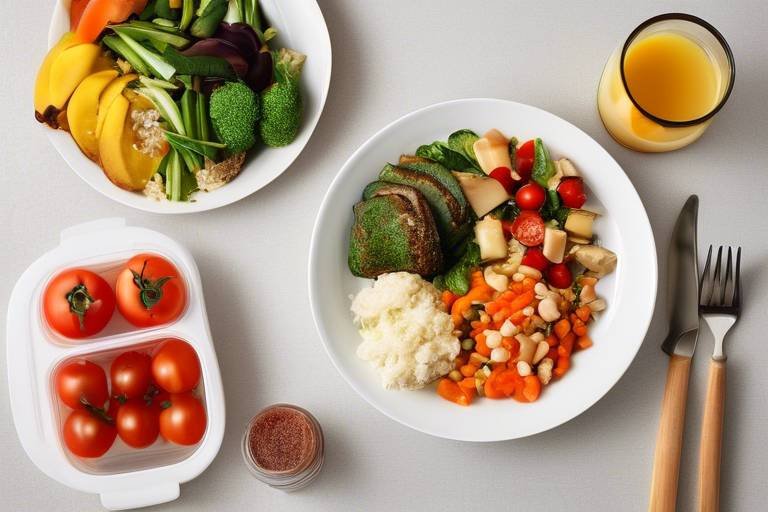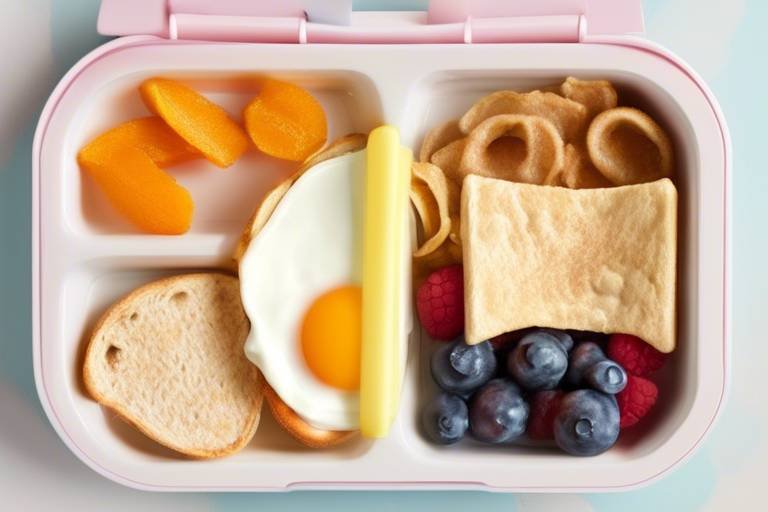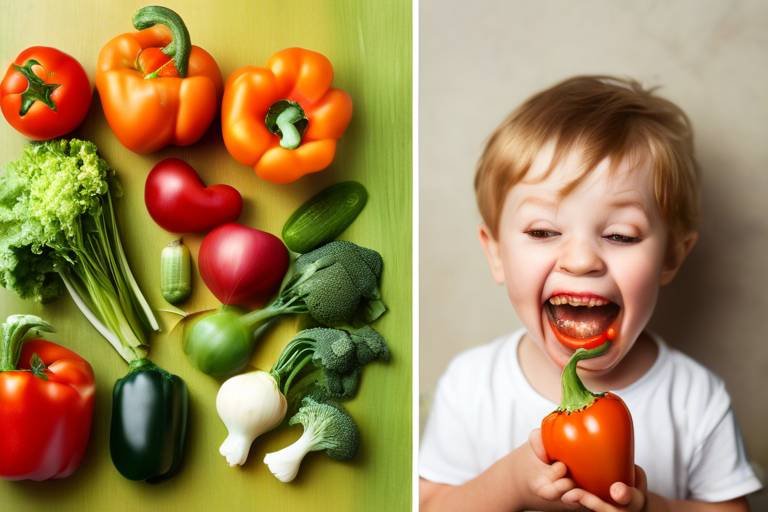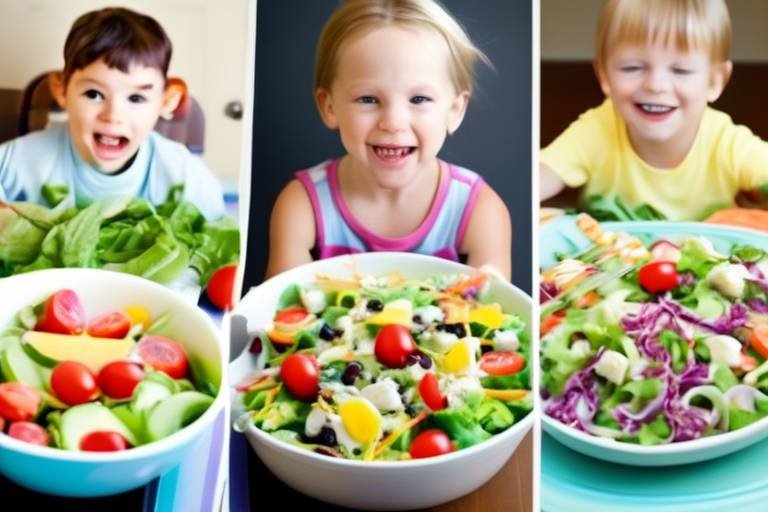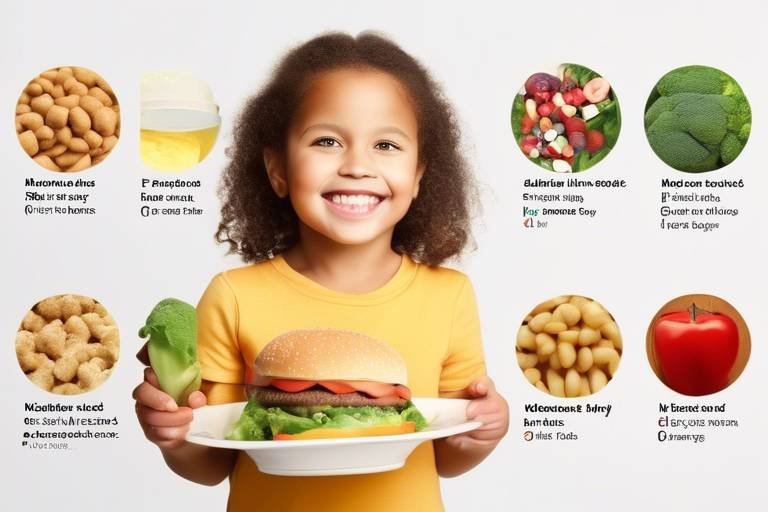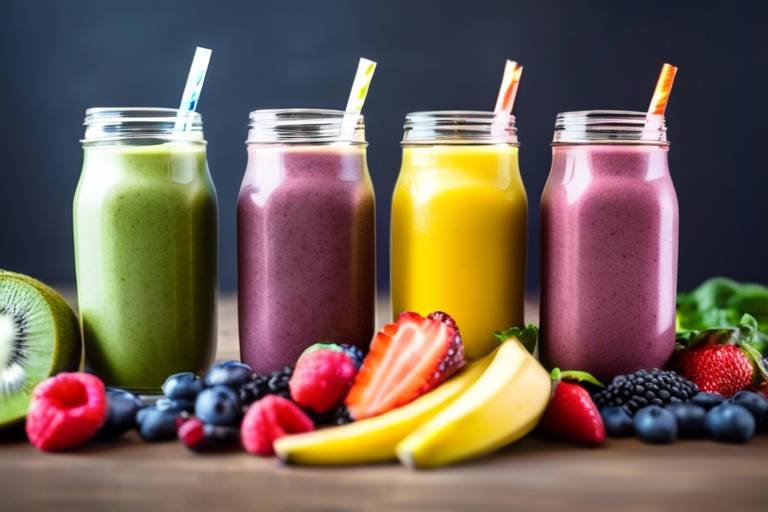How to Make a Nutritional Meal Using Leftovers
In today’s fast-paced world, we often find ourselves with leftover food that, instead of being tossed out, can be transformed into nutritious meals. Not only does this practice help us save money, but it also plays a crucial role in reducing food waste, which is a growing concern globally. Imagine turning last night’s dinner into a gourmet lunch or a hearty breakfast! In this article, we’ll explore creative ways to revamp those leftovers into exciting dishes that are both tasty and healthy. You’ll discover tips, recipes, and techniques that will not only maximize your leftovers but also ensure you maintain a balanced diet.
Leftovers come in various forms, from half-eaten meals to excess ingredients that didn’t make it into your last dish. Understanding the types of leftovers you have is the first step in making the most of them. For instance, cooked proteins like chicken or beef can be repurposed in salads or sandwiches, while vegetables can be blended into soups or stir-fries. It's essential to recognize the nutritional value of these foods. Many leftovers are still packed with vitamins and minerals, making them a valuable part of your diet. Proper storage is key to ensuring they remain safe and delicious for future meals. Always refrigerate leftovers promptly in airtight containers, and remember the general rule: if it smells or looks off, it's better to be safe than sorry!
Effective meal planning can be a game-changer when it comes to utilizing leftovers creatively. By planning your meals for the week, you can incorporate those remnants into your daily diet seamlessly. This not only helps in reducing waste but also ensures you have a variety of flavors and nutrients throughout the week. Start by taking stock of what leftovers you have and think about how they can fit into your meal plan. For example, if you have leftover rice, consider making a stir-fry or a rice salad. The possibilities are endless!
Creating a versatile meal plan that integrates leftovers effectively allows for a medley of flavors and textures while maintaining nutritional balance. Begin by listing out your leftover ingredients and brainstorming meals that can incorporate them. You might find that roasted vegetables from one night can become the base for a hearty grain bowl the next day. This approach not only saves time but also keeps your meals exciting and diverse.
Selecting the right recipes for your leftovers can enhance their appeal significantly. Look for recipes that complement your existing ingredients. For instance, if you have leftover grilled chicken, consider recipes for chicken tacos or a chicken salad. Websites and apps that focus on meal prep often allow you to input ingredients and suggest recipes based on what you have. This can be a fantastic way to discover new dishes while minimizing food waste!
To ensure your meals are nutritionally balanced, it’s essential to combine different food groups effectively. A well-rounded meal typically includes proteins, carbohydrates, and a variety of vegetables. For example, if you have leftover quinoa, pair it with sautéed greens and a protein source like beans or chicken. This combination not only fills you up but also provides a spectrum of nutrients your body craves. Remember, a colorful plate is often a nutritious plate!
Transforming leftovers into new dishes can be both fun and rewarding. Think of it as a culinary adventure! For instance, leftover pasta can be turned into a pasta bake by adding some cheese and veggies, while stale bread can be converted into delicious croutons or a bread pudding. The key is to get creative and not shy away from experimenting. You might just stumble upon your new favorite dish!
To take your leftover meals to the next level, consider enhancing their flavors with fresh herbs, spices, and sauces. A sprinkle of fresh basil or a dash of hot sauce can breathe new life into a bland dish. Don’t hesitate to experiment with different flavor profiles to find what works best for you. A little creativity can transform a simple leftover into a culinary masterpiece!
Incorporating fresh ingredients can significantly elevate leftover meals. Pairing fresh produce with your leftovers not only adds a burst of flavor but also increases the nutritional value of your dish. For example, adding fresh spinach to a leftover pasta dish can provide a boost of vitamins and minerals. Plus, the vibrant colors of fresh ingredients can make your meals more visually appealing, turning every plate into a work of art!
Different cooking techniques can bring new life to leftovers. Why not try roasting, sautéing, or grilling to create delicious and nutritious meals from what you have on hand? For instance, roasting leftover vegetables can caramelize their natural sugars, enhancing their flavor and making them irresistible. Similarly, grilling leftover meats can impart a smoky flavor that makes them taste fresh off the grill! The methods you choose can make all the difference in how your leftovers are enjoyed.
Q: How long can I keep leftovers in the fridge?
A: Generally, leftovers can be stored in the refrigerator for 3 to 4 days. Always check for signs of spoilage before consuming.
Q: Can I freeze leftovers?
A: Yes! Freezing is a great way to extend the life of your leftovers. Just make sure to store them in airtight containers to prevent freezer burn.
Q: What are some easy recipes for using leftovers?
A: Some easy recipes include stir-fries, casseroles, and soups. You can also make wraps or sandwiches using leftover proteins and vegetables!

Understanding Leftovers
When we talk about leftovers, we're diving into a world of culinary possibilities that often go unappreciated. Leftovers can be any food that remains uneaten after a meal, ranging from last night’s pasta to that half-eaten pizza sitting in your fridge. But did you know that these remnants can be a treasure trove of nutrients? Understanding the various types of leftovers and their nutritional value is essential for transforming them into delightful meals.
Leftovers can be categorized into several types, including:
- Cooked Foods: These are meals that have been prepared and served but not finished. Think of roasted chicken, stir-fried vegetables, or casseroles.
- Raw Ingredients: Often, we buy more fresh produce than we can consume in one go. Leftover veggies or fruits can easily be incorporated into new dishes.
- Grains and Carbs: Items like rice, pasta, and bread can be repurposed in various ways, making them versatile components in your meal planning.
So, how do we ensure these leftovers stay safe and delicious for future meals? Proper storage is key! Here are some tips to keep in mind:
| Type of Food | Storage Method | Shelf Life |
|---|---|---|
| Cooked Foods | Store in airtight containers | 3 to 4 days in the fridge |
| Raw Ingredients | Keep in original packaging or bags | 1 week for most veggies |
| Grains and Carbs | Seal in containers or bags | 3 to 5 days in the fridge |
By understanding how to store your leftovers safely, you can prevent food waste and ensure that your meals remain both nutritious and delicious. Plus, leftovers can save you time and money, allowing you to whip up a quick meal without starting from scratch. It’s like having a meal starter at your fingertips!
Moreover, when you think about leftovers, consider their nutritional value. Many cooked meals are packed with essential nutrients, and repurposing them can maintain their health benefits. For instance, leftover roasted vegetables can be tossed into a salad or blended into a soup, preserving their vitamins and minerals while adding flavor and texture to new dishes.
In summary, understanding leftovers is about recognizing their potential. They are not just remnants of a meal but ingredients waiting to be transformed into something new and exciting. By safely storing them and appreciating their nutritional value, you can make the most of your meals while reducing food waste and enhancing your culinary repertoire.

Planning Your Meals
When it comes to transforming leftovers into delightful meals, effective meal planning is your best friend. Think of meal planning as a treasure map that guides you through the culinary wilderness of your fridge, helping you unearth hidden gems—those delicious leftovers just waiting to shine again. By incorporating leftovers into your weekly meal prep, you can not only create balanced nutrition but also significantly reduce food waste. It’s a win-win situation! But how do you go about it?
Start by taking inventory of what you have. Open your fridge and take a good look at those containers filled with yesterday's dinner. Are there any half-eaten sides, a lone chicken breast, or some wilting veggies? Make a list of these items, as they will serve as the foundation for your meal plan. You can even create a simple table to visualize what you have:
| Leftover Item | Potential Use |
|---|---|
| Roasted Chicken | Chicken Salad, Tacos, Stir-fry |
| Cooked Rice | Fried Rice, Rice Bowls, Soup |
| Steamed Vegetables | Omelets, Pasta, Stir-fry |
Once you have your list, it’s time to get creative! Think about how you can repurpose these items into new dishes. For example, that roasted chicken can be shredded and tossed into a salad, or mixed with some salsa for a quick taco filling. The possibilities are endless, and this is where the fun begins! But remember, variety is key. Aim to incorporate different flavors and textures to keep your meals exciting.
In addition to creativity, consider the nutritional balance of your meals. A well-rounded plate should ideally include proteins, carbohydrates, and plenty of vegetables. This not only ensures you’re getting a full spectrum of nutrients but also makes your meals more satisfying. For instance, if you’re using leftover rice, pair it with some grilled chicken and a side of steamed broccoli. This combination will not only fill you up but also provide a colorful and appealing plate.
Another important aspect of meal planning is timing. Set aside a specific day each week to plan your meals. This could be a Sunday afternoon where you sit down with your list of leftovers and brainstorm how to use them throughout the week. By having a clear plan, you’ll save time during busy weekdays and avoid the dreaded “What’s for dinner?” dilemma.
Lastly, don’t forget to be flexible. Life happens, and sometimes you may not feel like eating what you had planned. That’s perfectly okay! The key is to keep your meal plan adaptable. If you find that you’re not in the mood for a specific dish, swap it out for another leftover creation. The goal is to enjoy your meals while minimizing waste, so allow yourself the freedom to change things up as needed.
In conclusion, planning your meals around leftovers is not just about saving money or reducing waste; it’s about embracing the creativity that cooking can offer. So, next time you find yourself staring at a fridge full of leftovers, remember that with a little planning and imagination, you can whip up a variety of nutritious and delicious meals that will keep your taste buds happy!
- How long can I keep leftovers in the fridge? Generally, leftovers should be consumed within 3-4 days for optimal freshness and safety.
- Can I freeze leftovers? Yes! Most leftovers freeze well, just make sure to store them in airtight containers.
- What are some easy recipes for using leftovers? Some popular options include stir-fries, casseroles, and soups, which can easily incorporate various leftover ingredients.

Creating a Meal Plan
Creating a meal plan is like crafting a delicious recipe for success in your kitchen. It’s not just about what you eat, but how you can turn those leftovers into something new and exciting. Think of meal planning as your culinary adventure map, guiding you through the week while ensuring you make the most of every ingredient. The first step is to assess what leftovers you have on hand. Take a good look in your fridge; you might find some forgotten treasures lurking in the back. This is where the magic begins!
Once you’ve identified your leftovers, it’s time to get creative. Start by categorizing your ingredients. For instance, if you have leftover roasted chicken, some steamed broccoli, and a bit of rice, you can easily brainstorm multiple meal options. You could whip up a chicken stir-fry, a hearty soup, or even a flavorful casserole. The key is to think outside the box and let your imagination run wild. You’re not just using leftovers; you’re transforming them into something that feels fresh and exciting!
To make the planning process smoother, consider creating a weekly meal schedule. This doesn’t have to be overly complicated; a simple table can do the trick. Here’s a basic example:
| Day | Leftover Ingredient | New Dish |
|---|---|---|
| Monday | Roasted Chicken | Chicken Stir-Fry |
| Tuesday | Steamed Broccoli | Broccoli Cheese Casserole |
| Wednesday | Rice | Fried Rice |
| Thursday | Mixed Vegetables | Vegetable Soup |
| Friday | Leftover Sauce | Pasta with Sauce |
By laying out your meals in a table, you can see at a glance how to utilize your leftovers throughout the week. This not only helps in reducing food waste but also ensures that you maintain a balanced diet. You can mix and match ingredients based on your cravings and nutritional needs. Remember, variety is the spice of life, and it keeps your meals from becoming monotonous!
Moreover, don’t forget to keep an eye on your pantry staples. Ingredients like grains, legumes, and canned goods can complement your leftovers beautifully. For example, if you have leftover grilled vegetables, toss them with some quinoa and a simple vinaigrette for a refreshing salad. The goal here is to create a harmonious balance between what you already have and what you can easily incorporate to enhance your meals.
In essence, meal planning with leftovers is about being resourceful and imaginative. It’s about taking what you have and making it work for you, all while saving time and money. So, roll up your sleeves, grab that spatula, and let’s get cooking!

Choosing the Right Recipes
When it comes to transforming your leftovers into something delightful, the key lies in selecting the right recipes. You might be wondering, "How do I find recipes that will breathe new life into my leftover meals?" Well, it’s easier than you think! Start by taking a good look at what you have in your fridge. Are there any proteins like chicken or beef? Maybe some grains like rice or quinoa? Or perhaps a medley of roasted vegetables? Each of these can serve as a foundation for a whole new dish.
One effective approach to choosing recipes is to consider the flavors and textures of your leftovers. For instance, if you have leftover roasted vegetables, they could easily be tossed into a stir-fry, blended into a soup, or even mixed into a frittata. On the other hand, if you have a chunk of grilled chicken, why not turn it into a savory chicken salad or a hearty wrap? The possibilities are endless, and the best part is that you can experiment with different combinations!
Another tip is to think about cuisine styles. Leftovers can often be revitalized by incorporating elements from different culinary traditions. For example, leftover rice could be transformed into a delicious fried rice dish with a few added veggies and some soy sauce, or you could use it as a base for a Mexican-inspired rice bowl topped with beans, salsa, and avocado. This not only reduces waste but also keeps your meals exciting and varied.
If you’re looking for inspiration, consider utilizing online resources or cookbooks that focus on leftover meals. Many websites offer sections dedicated to using up leftovers, complete with user-friendly recipes. You can also join social media groups where home cooks share their creative ideas for repurposing food. Remember, the goal is to keep it simple and fun while making sure your meals are still nutritionally balanced.
To make it even easier, here’s a quick table summarizing some common leftovers and potential recipe ideas:
| Leftover | Recipe Ideas |
|---|---|
| Cooked Chicken | Chicken Salad, Chicken Tacos, Stir-fried Rice |
| Roasted Vegetables | Vegetable Frittata, Stir-fry, Soup |
| Cooked Rice | Fried Rice, Rice Bowl, Stuffed Peppers |
| Pasta | Pasta Bake, Pasta Salad, Stir-fry |
In conclusion, choosing the right recipes for your leftovers can transform what might seem like a mundane meal into something extraordinary. By considering the ingredients you have, experimenting with different cuisines, and seeking inspiration, you can create delicious, nutritious meals that not only satisfy your taste buds but also help in reducing food waste. So, next time you find yourself staring at a fridge full of leftovers, remember that with a little creativity, you can whip up something amazing!
- What types of leftovers are best for repurposing? Almost any type of leftover can be transformed! Proteins, grains, and vegetables are the most versatile.
- How can I ensure my leftover meals are nutritious? Aim to include a balance of proteins, carbohydrates, and vegetables in your new dishes.
- Are there any cooking techniques that can enhance leftovers? Yes! Techniques like roasting, sautéing, and grilling can add new flavors and textures to your meals.
- Where can I find recipe ideas for leftovers? Online recipe sites, cookbooks, and social media groups are great resources for finding creative leftover recipes.

Balancing Nutrients
When it comes to transforming your leftovers into a nutritious meal, is essential. Think of your plate as a canvas, where each food group plays a crucial role in creating a masterpiece of flavors and health benefits. To ensure your meal is not just satisfying but also nourishing, you need to incorporate a variety of food groups. This means including proteins, carbohydrates, and vegetables in your dishes. Each component contributes uniquely to your overall health. For instance, proteins are vital for muscle repair and growth, carbohydrates provide energy, and vegetables are packed with essential vitamins and minerals.
To achieve this balance, consider the following tips:
- Proteins: Use leftover meats, beans, or legumes. They can be the star of your dish, providing the necessary protein to keep you full and satisfied.
- Carbohydrates: Don’t forget about grains! Leftover rice, quinoa, or pasta can serve as a hearty base for your meal.
- Vegetables: Incorporating leftover veggies not only adds color but also boosts the nutritional profile of your meal. Think about sautéing or roasting them to enhance their flavors.
For example, if you have some leftover grilled chicken, you could pair it with a bed of quinoa and a medley of sautéed vegetables. This combination not only satisfies your hunger but also offers a balanced intake of nutrients. Additionally, consider the portion sizes of each food group to ensure you’re not overloading on any one category, which can lead to an imbalance in your diet.
Moreover, it’s beneficial to think about the color on your plate. A variety of colors often indicates a variety of nutrients. Aim for a rainbow of vegetables, as different colors typically represent different vitamins and minerals. For instance, dark leafy greens are rich in iron and calcium, while orange and yellow vegetables are often high in vitamin C and beta-carotene.
In summary, balancing nutrients in your meals made from leftovers not only helps in reducing waste but also promotes a healthier lifestyle. By being mindful of the food groups you include and their respective benefits, you can create delicious meals that are both satisfying and nourishing.
Q: How can I ensure my leftovers are safe to eat?
A: Always store leftovers in airtight containers and refrigerate them within two hours of cooking. Consume them within 3-4 days for optimal safety.
Q: What are some easy ways to incorporate more vegetables into my leftover meals?
A: Try adding leftover vegetables to soups, stir-fries, or omelets. You can also blend them into sauces or smoothies for added nutrition.
Q: Can I freeze leftovers for later use?
A: Yes! Most leftovers can be frozen for up to three months. Just make sure to label them with the date and contents for easy identification later.

Incorporating Leftovers into New Dishes
Transforming leftovers into new and exciting dishes is not just a practical approach to reducing waste; it’s also a fantastic way to unleash your culinary creativity! Think of your leftovers as a blank canvas, just waiting for a splash of flavor and a dash of imagination. Instead of viewing them as yesterday's meals, consider how they can be repurposed into something entirely new and delicious. For instance, leftover roasted chicken can easily become a savory chicken salad or a hearty soup that warms the soul. The key is to look at what you have and ask yourself, "What can I create with this?"
Start by assessing your leftovers. Are they proteins, grains, or vegetables? Understanding the components of your leftovers can help you decide how to incorporate them into new dishes. For example, if you have leftover rice, you could stir-fry it with some fresh veggies and a splash of soy sauce for a quick fried rice dish. Similarly, roasted vegetables can be blended into a creamy soup or tossed into a frittata, creating a delightful breakfast option. The possibilities are endless!
Another fun way to incorporate leftovers is by experimenting with different cuisines. If you have leftover taco meat, why not turn it into a spicy quesadilla or a zesty burrito bowl? On the other hand, leftover pasta can be transformed into a delicious pasta bake, topped with cheese and baked until bubbly. The trick is to think outside the box and not be afraid to mix and match flavors and textures.
Here are some creative ideas to get you started:
- Wrap It Up: Use leftover meats, veggies, or grains to create wraps or sandwiches. They’re quick, easy, and perfect for lunch!
- Soup It Up: Almost any leftover can be turned into a hearty soup. Just add broth and some fresh herbs for a comforting dish.
- Frittata or Omelette: Combine leftover vegetables and proteins into a frittata or omelette for a nutritious breakfast or brunch option.
- Grain Bowls: Layer your leftovers with fresh greens, grains, and a tasty dressing to create a nourishing grain bowl.
Don’t forget the power of sauces and toppings! A simple sauce can elevate your leftover dish from mundane to magnificent. A drizzle of balsamic glaze, a sprinkle of fresh herbs, or a dollop of yogurt can add that extra flair. Remember, it’s all about enhancing the flavors and making the dish appealing to both the eyes and the palate.
Incorporating leftovers into new dishes not only saves you time and money but also allows you to enjoy a variety of meals throughout the week. So next time you find yourself with a fridge full of leftovers, embrace the challenge! Get creative, have fun, and turn those remnants into something extraordinary.
Q: How long can I keep leftovers in the fridge?
A: Generally, leftovers can be safely stored in the fridge for up to 3-4 days. Always ensure they are stored in airtight containers to maintain freshness.
Q: Can I freeze leftovers?
A: Yes! Most leftovers can be frozen for future use. Just make sure to cool them down before placing them in freezer-safe containers. They can last for several months in the freezer.
Q: What are some tips for reheating leftovers?
A: When reheating, it’s best to use the oven or stovetop for even heating. Microwave reheating can lead to uneven temperatures. Always ensure your food reaches an internal temperature of 165°F (74°C) before consuming.
Q: How can I make leftovers taste fresh again?
A: Adding fresh ingredients like herbs, spices, or citrus can brighten up leftover dishes. Consider incorporating new sauces or toppings to enhance flavors.

Flavor Enhancements
When it comes to leftovers, the key to transforming them from mundane to magnificent lies in the art of flavor enhancement. Think of your leftover meals as a blank canvas; with the right ingredients and techniques, you can create a masterpiece that tantalizes the taste buds. So how do you elevate your leftovers? It all starts with the right herbs, spices, and sauces that can breathe new life into your dishes.
First off, let’s talk about herbs and spices. These little powerhouses can make a world of difference. Imagine a simple leftover chicken breast that, with just a sprinkle of paprika and a dash of garlic powder, turns into a zesty delight. Fresh herbs like basil, cilantro, or parsley can add a burst of freshness, while dried herbs such as oregano and thyme provide depth and warmth. Don't be afraid to experiment! A pinch of cayenne can add heat, while a touch of cinnamon can introduce an unexpected sweetness that surprises your palate.
Next, consider the role of sauces. A good sauce can tie all the flavors together and add moisture to your leftovers. For example, a drizzle of balsamic reduction can transform roasted vegetables into a gourmet side dish, while a creamy alfredo sauce can make leftover pasta feel like a restaurant-quality meal. You can even whip up a quick homemade sauce using pantry staples. A simple mixture of olive oil, lemon juice, and mustard can serve as a vibrant dressing for salads or a marinade for grilled meats.
Additionally, think about layering flavors. This technique involves adding different components at various stages of cooking to build complexity. Start by sautéing onions and garlic in olive oil to create a fragrant base. Then, add your leftovers and let them absorb those rich flavors. Finish with a splash of vinegar or a squeeze of citrus to brighten everything up. This not only enhances the taste but also makes your dish visually appealing.
For those who enjoy a bit of crunch, consider adding some textural elements. Toasted nuts, seeds, or crispy fried onions can add a delightful contrast to softer leftover dishes. Imagine a creamy leftover risotto topped with toasted pine nuts or a hearty stew garnished with crispy shallots. These additions not only enhance flavor but also provide a satisfying crunch that elevates the overall eating experience.
Finally, don’t forget about incorporating fresh ingredients. Pairing your leftovers with fresh produce can enhance both nutrition and flavor. For instance, mixing leftover quinoa with fresh diced tomatoes, cucumbers, and a squeeze of lemon creates a refreshing salad that feels light and vibrant. The combination of cold, fresh ingredients with warm leftovers can create a delightful contrast that keeps your meals exciting.
In summary, enhancing the flavors of your leftovers is all about creativity and a little bit of experimentation. By incorporating herbs, spices, sauces, and fresh ingredients, you can transform a simple meal into something extraordinary. So next time you find yourself staring at a fridge full of leftovers, remember that with a few flavorful tweaks, you can create a dish that’s not just nutritious but also incredibly delicious!
- What are some easy herbs to use for flavoring leftovers? Fresh basil, cilantro, and parsley are great options, while dried oregano and thyme can add depth.
- How can I make my leftover meals more appealing? Use sauces, fresh ingredients, and textural elements like nuts or crispy toppings to enhance both taste and presentation.
- Can I freeze leftover sauces for later use? Absolutely! Most sauces freeze well and can be a great way to save time in future meals.

Using Fresh Ingredients
When it comes to breathing new life into your leftover meals, fresh ingredients are your best friends. Imagine transforming a sad, leftover casserole into a vibrant, flavorful dish just by adding a handful of fresh herbs or a squeeze of lemon. Fresh produce not only enhances the taste but also ramps up the nutritional value of your meals. So, how do you incorporate these fresh ingredients into your leftovers? Let’s dive into some exciting ways!
First off, consider the types of fresh ingredients that can complement your leftovers. For instance, if you have leftover roasted chicken, adding fresh greens like spinach or arugula can create a delightful salad. You can toss in some cherry tomatoes, cucumbers, or even a sprinkle of feta cheese for that extra zing. The combination of textures and flavors can turn a simple leftover into a gourmet experience!
Moreover, fresh herbs are a game changer! A sprinkle of basil, cilantro, or parsley can elevate your dish from mundane to magnificent. These herbs not only add a burst of flavor but also bring a fresh aroma that can make your meal feel like it was just prepared from scratch. For example, if you have leftover pasta, tossing it with some freshly chopped basil, garlic, and a drizzle of olive oil can transform it into a deliciously vibrant dish.
Another tip is to use fresh ingredients to create a sauce or dressing that can be drizzled over your leftovers. A homemade vinaigrette made from fresh lemon juice, olive oil, and a touch of mustard can add a refreshing kick. You can even blend fresh fruits like avocados or mangoes into a creamy dressing that pairs beautifully with grilled meats or roasted vegetables.
Don’t forget about the power of fresh spices! Adding a pinch of freshly ground pepper or a dash of chili flakes can give your leftovers the kick they need. Experimenting with spices can also help you discover new flavor profiles that you might not have considered before. For instance, if you have leftover rice, mixing in some freshly chopped jalapeños and cilantro can create a zesty side dish.
Incorporating fresh ingredients into your leftover meals not only enhances flavor but also ensures that you’re getting a variety of nutrients. Fresh fruits and vegetables are packed with vitamins, minerals, and antioxidants that can boost your health. So, the next time you’re staring at a fridge full of leftovers, remember that a little creativity with fresh ingredients can make all the difference!
- Can I use frozen vegetables instead of fresh? Absolutely! Frozen vegetables can be a convenient alternative and still provide great nutritional value. Just be sure to cook them properly to maintain their texture.
- How do I store fresh herbs? Fresh herbs can be stored in a glass of water in the fridge, or you can wrap them in a damp paper towel and place them in a plastic bag. This helps keep them fresh for longer.
- What are some easy fresh ingredients to keep on hand? Some great staples include spinach, tomatoes, cucumbers, bell peppers, and various herbs. These can easily complement a variety of leftovers.

Experimenting with Cooking Techniques
When it comes to transforming leftovers into something extraordinary, is your best friend. Have you ever thought about how a simple change in cooking method can elevate a dish from mundane to magical? Just like a painter uses different brushes to create stunning artwork, you can use various cooking techniques to breathe new life into your leftover meals. Think of your leftovers as a blank canvas, waiting for your culinary creativity to turn them into a masterpiece.
One of the easiest ways to change the flavor profile of your leftovers is through roasting. This technique can caramelize the natural sugars in vegetables or proteins, adding depth and richness. For example, leftover roasted chicken can be tossed with some seasonal vegetables and roasted again, creating a delightful medley that feels fresh and new. The key is to keep an eye on the cooking time; you want to warm your leftovers without drying them out.
Another fun technique is sautéing. This method allows for quick cooking and can infuse your leftovers with vibrant flavors. Imagine sautéing leftover rice with a splash of soy sauce, a sprinkle of sesame oil, and tossing in some fresh veggies. You’ll end up with a colorful stir-fry that not only looks appetizing but also packs a nutritional punch. Sautéing is all about speed and flavor, making it perfect for those busy weeknights.
If you’re feeling adventurous, why not try grilling? Grilling isn’t just for fresh ingredients; it can be a fantastic way to add a smoky flavor to your leftovers. For instance, leftover grilled vegetables can be reheated on the grill to enhance their taste, or you can create a grilled cheese sandwich using leftover meats and cheeses. The grill adds a charred flavor that can turn a simple meal into something that feels gourmet.
But let’s not forget about blending! Have some leftover soup or sauce? Why not blend it into a creamy dip or a base for a new dish? A simple leftover tomato soup can be transformed into a luscious pasta sauce with just a few additional spices and a quick blend. This technique not only saves time but also minimizes waste, allowing you to use every bit of what you have.
As you explore these techniques, remember that the right seasoning can make a world of difference. Don’t hesitate to experiment with herbs and spices that complement your leftovers. A pinch of cumin can add warmth to a vegetable medley, while fresh basil can brighten up a pasta dish. The possibilities are endless when you let your imagination run wild!
In summary, experimenting with cooking techniques is a fun and creative way to transform your leftovers into exciting new meals. Whether you roast, sauté, grill, or blend, each method can bring out unique flavors and textures that make your dishes feel fresh. So next time you’re staring at that container of leftovers in your fridge, remember: it’s not just leftovers; it’s an opportunity to create something delicious!
- Can I use any leftovers for these cooking techniques? Yes! Most leftovers can be repurposed using these techniques, just be mindful of the original ingredients and how they might react to different cooking methods.
- How can I ensure my leftovers stay fresh for longer? Store them in airtight containers and refrigerate promptly. You can also freeze leftovers for extended freshness.
- What if I don’t have the right ingredients for a recipe? Get creative! Use what you have on hand and substitute ingredients as necessary. Cooking is all about improvisation!
Frequently Asked Questions
- What types of leftovers can I use to create nutritious meals?
You can use a wide variety of leftovers, such as cooked meats, grains, vegetables, and even sauces. The key is to be creative! For instance, leftover roasted chicken can be turned into a hearty soup, while extra rice can be used in stir-fries or salads.
- How can I safely store leftovers to maintain their quality?
To keep your leftovers fresh, store them in airtight containers and refrigerate them within two hours of cooking. Make sure to label them with the date they were made, and try to consume them within three to four days. If you want to keep them longer, freezing is a great option!
- What are some tips for meal planning with leftovers?
Meal planning with leftovers is all about versatility. Start by taking stock of what you have and think about how to incorporate those items into your meals for the week. Create a meal plan that includes a mix of new recipes and leftover transformations to keep things interesting and minimize waste.
- How can I enhance the flavors of my leftover meals?
Spices, herbs, and sauces are your best friends when it comes to enhancing leftover meals. A sprinkle of fresh herbs or a dash of hot sauce can completely transform a dish. Don't be afraid to experiment with different flavor profiles to make your meals exciting!
- Can I incorporate fresh ingredients with my leftovers?
Absolutely! Fresh ingredients can add a burst of flavor and nutrition to your leftover meals. Consider adding fresh vegetables, herbs, or even a squeeze of lemon juice to brighten up a dish. This not only enhances taste but also boosts the nutritional value!
- What cooking techniques can I use to repurpose leftovers?
Different cooking techniques can breathe new life into leftovers. Try sautéing vegetables with leftover grains for a quick stir-fry, or roasting them for added flavor. Grilling can also add a smoky touch to your leftover proteins, making them more enticing!

